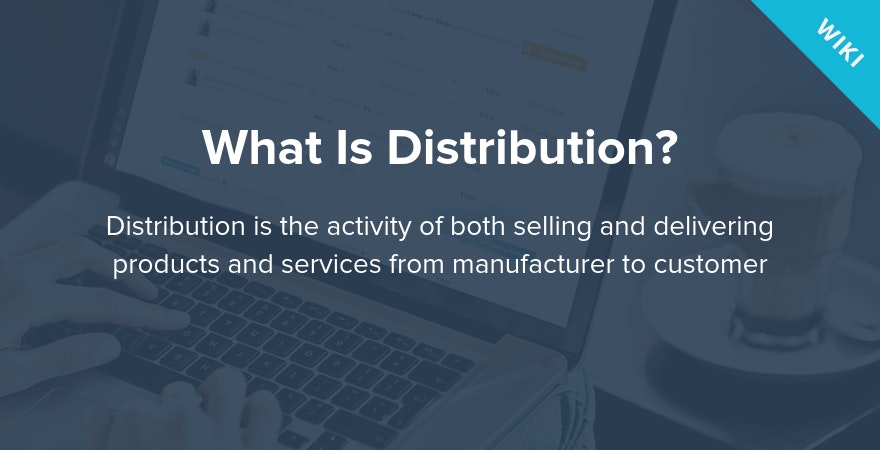
Distribution



What is distribution?
Distribution is the activity of both selling and delivering products and services from manufacturer to customer. The process begins with the procurement of raw materials and includes several stages such as transportation, warehousing, and inventory management, culminating in the final delivery of the product to the end consumer.
A distributor is an intermediary that bridges the gap between the manufacturer and the customer in the distribution process. They take the products from the manufacturers, store them in warehouses, and then manage their transportation to the various points of sale or directly to the consumers.
→ Click Here to Launch Your Online Business with Shopify
Types of distribution strategies
There are three main types of distribution strategies: intensive distribution, selective distribution, and exclusive distribution.
Intensive distribution
Intensive distribution, also known as mass distribution, is a strategy in which a company tries to distribute its products or services as widely as possible in the market. This strategy is commonly used for convenience products such as soft drinks or personal care items.
The goal of intensive distribution is to make the product available in as many outlets as possible, capitalizing on high demand and frequent purchases.
Selective distribution
Selective distribution involves a company using a limited number of outlets in a specific geographical area to sell its products. This strategy is typically used for specialty products or services that are not as widely demanded by the market.
By limiting the number of outlets, selective distribution aims to provide better sales support and service, ensuring a higher quality customer experience.
Exclusive distribution
Exclusive distribution is a strategy in which a manufacturer grants a single retail outlet or distributor the exclusive rights to sell a product in a specific geographical area. This is often used for high-end products or services that require a certain level of sales support or service.
The aim of exclusive distribution is to maintain the product's prestigious image and control its market positioning, providing a unique and exclusive buying experience for customers.
What is a distribution channel?
A distribution channel is the path taken by a product or service from the producer to the final consumer. It includes all the intermediaries involved in the process of getting the product from the manufacturer to the market. Intermediaries in a distribution channel can include wholesalers, distributors, suppliers, dropshipping platforms, print-on-demand companies, and other retailers.
When a manufacturer sells directly to the consumer, bypassing these intermediaries, it's known as a direct distribution channel. Conversely, when one or more intermediaries are involved in the process, it's referred to as indirect distribution.
Direct distribution
Direct distribution gives manufacturers complete control over their product. They can set their own prices, control the customer experience, and build direct relationships with their customers. This can be beneficial for building brand loyalty and for businesses with unique products that require a specific sales approach.
For example, a small artisanal cheese maker might choose a direct distribution strategy, selling their products online and at local farmers markets. This allows them to control the way their products are presented and sold, and to receive direct feedback from their customers.
However, direct distribution can also be resource-intensive. Manufacturers are responsible for every step of the distribution process, from storage and inventory management to shipping and customer service. This requires a significant investment in infrastructure and logistics.
Indirect distribution
An indirect distribution channel involves one or more intermediaries, such as wholesalers, retailers, or distributors. These intermediaries purchase products from the manufacturer and then sell them to the end consumer.
Since these intermediaries curate a diverse array of products from a wide range of manufacturers, indirect distribution typically allows retailers to expand their inventory and provide more options to customers. It can also reduce the manufacturer's workload, as the intermediaries typically handle storage, transportation, and selling.
However, this approach does come with a trade-off: while indirect distribution can reduce the workload for retailers, it also typically means they must apply a higher markup to cover the cost of the intermediaries—potentially affecting the competitiveness of their pricing.
What is distribution management?
Distribution management is the coordination and supervision of the transfer of goods from a manufacturer or supplier to the point of sale. It's a comprehensive process that includes a wide range of activities, such as inventory management, order fulfillment, demand forecasting, and logistics coordination, all aimed at ensuring that products are available to customers in the right place at the right time.
Several factors can influence the effectiveness of distribution management:
- Packaging: The size, weight, and packaging of the product can impact transportation costs and storage requirements.
- Inventory management: Effective inventory management is crucial to ensure the right products are available at the right time.
- Order processing: Efficient order processing can improve customer satisfaction and reduce costs.
- Logistics: The logistics of moving the product from the manufacturer to the consumer need to be managed effectively.
- Nature of the product: Different products, like perishable versus non-perishable goods, require different distribution strategies.
- Type of market: Targeting a global market versus a local market presents different distribution challenges and needs.
- Overall business strategy: The distribution strategy should align with the broader business goals and objectives.
- Customer preferences: The buying habits and preferences of the target customers can influence distribution strategies.
- Regulatory environment: Laws and regulations related to the transportation and sale of goods can impact distribution practices.
- Technological capabilities: The use of technology can enhance inventory tracking, logistics management, and demand forecasting.
- Geographical considerations: Factors such as distance, infrastructure, and local conditions can influence the choice of distribution channels and the speed of delivery.